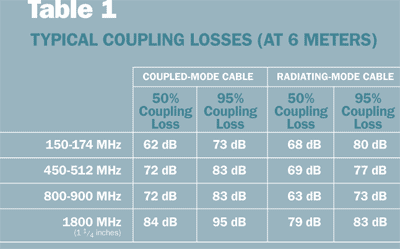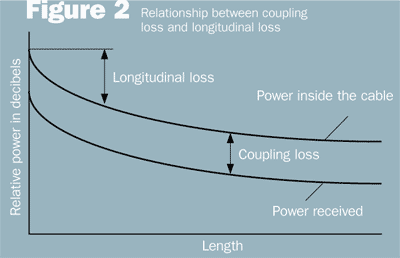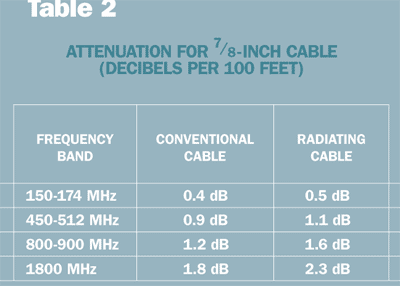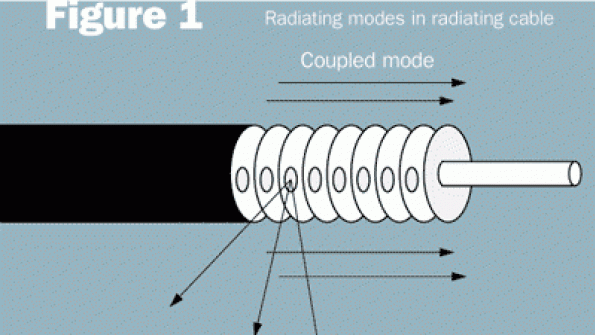Leaky cables are a good thing
Radiating or “leaky” coaxial cables are popular antennas for regions that are difficult to cover with conventional antennas. Examples of such areas are underground mines, railway and automobile tunnels, parking garages, hospitals, airports, office buildings, ships, underground military installations and offshore oil rigs.
Radiating cables sometimes are buried to provide information services to travelers using the AM and FM broadcast bands. Most leaky coaxial cable provides extremely high bandwidths that make possible a variety of services in several radio bands simultaneously. These services include broadcast radio, wireless local area networks, paging services and cellular radio. Radiating cable is one example of a distributed antenna system. Other distributed antenna systems consist of discrete antennas fed by coaxial cable or a combination of fiber-optic cable, twisted-pair cable and coaxial cable. We’ll talk more about distributed antenna systems in future issues.
When used in a distributed antenna system, radiating cables offer several advantages:
-
Reciprocity: The same cable can be used to simultaneously transmit and receive radio signals.
-
Wide bandwidth: Most designs can support frequencies from 30 MHz to 2400 MHz.
-
Control: Because radio frequency fields attenuate rapidly away from the cable, radiation can be controlled to prevent interference to other radio services.
One recent example of a large radiating cable project is the English Channel tunnel, or “Chunnel.” The Chunnel system has two parts: a radiating cable inside the train cars is re-radiated via an external antenna to a second radiating cable hung from the top of the tunnel. Another recent tunnel project is the Ted Williams tunnel in Boston [1]. Opened in 1995, the tunnel connects South Boston to Logan International Airport.
A radiating cable is a coaxial cable with apertures in its outer conductor. Several technologies have been developed to manufacture these apertures, from loose braid to corrugated and milled leaky cables and finally to slotted radiating cables. When the apertures or slots are spaced close together relative to a wavelength, the cable is a surface wave antenna [2] and performs in coupled mode. When the slots are spaced roughly a wavelength apart, the cable will operate in radiating mode. (We will use the term radiating cable to mean any leaky coaxial cable, in either coupled or radiating mode. To distinguish between modes, we will use the term radiating-mode cable as opposed to radiating cable.) The geometries of coupled-mode and radiating-mode radiation are shown in Figure 1.

Coupled-mode radiation is a type of surface wave. Surface waves have a power flow that runs parallel to the cable axis. In free space, very little energy leaves the immediate vicinity of the cable. In practical environments, the fields are reflected and diffracted and provide good coverage within a region roughly 20 feet around the cable.
Signals from coupled-mode cables exhibit large variations in amplitude as one travels parallel to the cable. Coupling loss from coupled-mode cables increases with frequency.
When the slots are cut to ensure an in-phase addition of all apertures, the cable is then a radiating-mode cable. Such cables are more efficient than coupled-mode cables because they direct energy perpendicular to the cable axis. Radiating-mode cables exhibit a stronger frequency dependence than do coupled-mode cables, but they still can be designed for broadband applications. If not designed properly, the cable will exhibit large attenuation spikes at resonant frequencies [3]. Radiating-mode cables show high coupling loss at low frequencies up to the radiating-mode frequency, ƒr. Above that frequency, the coupling loss drops rapidly and remains low for several hundred megahertz.
Radiating-mode cables also exhibit much smaller signal-level fluctuations than coupled-mode cables, and coupling loss from radiating-mode cables generally decreases with increasing frequency [4]. Tests in Europe also show that radiating-mode cables are less sensitive to masking by vehicles and other moving objects in the vicinity of the cable.
Coupling loss is the most important performance specification for radiating cable. Coupling loss is defined as the ratio (in decibels, or dB) of power received at a half-wave dipole located a fixed distance from the cable to the power inside the cable. Coupling loss varies widely as one travels parallel to the cable. To be meaningful, coupling loss should be reported as a statistical measure, not a constant.
The most common measure is the 50% coupling loss, meaning the loss exceeded by 50% of the sample points. Typical values of 50% coupling loss range from 50 dB to 80 dB for a distance of 20 feet (6 meters) from the cable. Another common measure is the 95% coupling loss (loss exceeded by just 5% of sample points). The 95% coupling loss is more meaningful than 50% coupling loss because no operator will settle for just 50% coverage. Also, two cables with identical 50% coupling losses could have significantly different 95% coupling losses. Typical coupling loss for ⊊-inch cable is shown in Table 1.

Coupling-loss specifications can be misleading because there is no universal standard for measuring such losses. One popular manufacturer uses a distance of 6 meters, but IEC 1196-4 specifies a distance of 1.5 meters. Some manufacturers use 50% coupling loss while others use 95% coupling loss. Coupling loss also varies with environment and frequency, so the test set-up and frequency must be specified for the results to be meaningful. Tests also should be conducted in accordance with IEC 1196-4 for European applications.
Note that coupling loss does not include the attenuation of the cable. The relationship between coupling loss and longitudinal loss (caused by attenuation) is shown in Figure 2.

Like conventional coaxial cables, the radiating cable’s attenuation (in dB/100 feet) increases with frequency. However, unlike conventional cables, radiating-cable attenuation varies with distance from the mounting structure. For example, Andrew engineers found that the attenuation of 1 ⅝-inch Radiax cable varied by almost 1 dB as the cable was moved from flush with the wall to a distance of 3 inches [3]. The designer also can trade off attenuation and coupling loss through the design of the slots. As depicted in Table 2 on page 40, when optimally mounted, the attenuation of radiating cable in dB/100 feet does not differ significantly from the attenuation of conventional coaxial cable of the same diameter.

Jay Jacobsmeyer is president of Pericle Communications Co., a consulting engineering firm located in Colorado Springs, Colo. He holds a bachelor’s and master’s degree in electrical engineering from Virginia Tech and Cornell University, respectively, and has more than 20 years experience as a radio frequency engineer.
Footnotes
-
P. Mailandt, “Boston breaks new ground on tunnel, radio communications,” Mobile Radio Technology, July 1996.
-
R.C. Johnson, Antenna Engineering Handbook, 3rd Ed., McGraw-Hill: 1993, Ch. 10.
-
S. Rampalli and H.R. Nudd, “Recent Advances in the Designs of Radiating (Leaky) Coaxial Cables,” International Wire & Cable Symposium Proceedings, 1991.
-
Radiating Cable Handbook, Radio Frequency Systems, Inc.
Additional references
P. Delogne, Leaky Feeders and Subsurface Radio Communications, Peter Peregrinus Ltd.: 1982.
MIL-C-17G, “Cables, Radio Frequency, Flexible and Semirigid, General Specification For,” 8 January 1996.
MIL-C-288830C, “Cable, Radio Frequency, Coaxial, Semirigid, Corrugated Outer Conductor, General Specification For,” 22 August 1994.

















